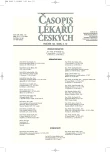Glucocorticoids and their Effect on Dendritic Cell Function
Glukokortikoidy a jejich vliv na funkci dendritických buněk
Východisko.
Dendritické buňky přestavují hlavní buňky, které zahajují imunitní reakci. Podílejí se na rozlišování cizího a vlastního a signálů nebezpečí, které pro organizmus představují škodliviny vnější, ale i vnitřní. Dendritické buňky také přispívají k udržování tolerance vůči vlastním tkáním. Glukokortikoidy jsou používány jako imunosupresiva a protizánětlivé léky a v transplantační medicíně k potlačení rejekce. Působení glukokortikoidů bylo zkoumáno zejména u monocytů a lymfocytů, ale jen ojedinělé studie byly zaměřeny na ovlivnění dendritických buněk glukokortikoidy. V naší studii jsme zkoumali vliv glukokortikoidů na diferenciaci a maturaci dendritických buněk in vitro a na ovlivnění subpopulací dendritických buněk in vivo po vysokodávkované kortikoterapii.
Metody a výsledky.
Na in vitro modelu (dendritické buňky vypěstované z periferních monocytů) jsme zjistili, že glukokortikoidy v koncentraci vyšší než 10⁻⁶ M indukují apoptózu dendritických buněk. V koncentracích nižších pak glukokortikoidy ovlivňují jak proces diferenciace, tak maturace dendritických buněk. Po podání Solumedrolu v bolusové dávce 1000 mg dochází in vivo během jednoho dne k praktickému vymizení plazmacytoidních dendritických buněk a výraznému snížení myeloidních dendritických buněk.
Závěry.
Tato studie prokazuje hluboký vliv kortikoidů na zahájení imunitní reakce, na funkci dendritických buněk. Dysfunkce dendritických buněk pod vlivem kortikoidů může být žádoucí ve smyslu potlačení patologické imunitní reakce, pro niž jsou kortikoidy indikovány, ale zároveň vysvětluje sklon ke zvýšené náchylnosti k infekcím u pacientů léčených kortikoidy.
Klíčová slova:
dendritická buňka, glukokortikoidy, Toll-like receptory, imunosupresivní terapie.
Authors:
D. Rožková; R. Horváth; J. Bartůňková; R. Špíšek
Authors‘ workplace:
Ústav imunologie 2. LF UK a FNM, Praha
Published in:
Čas. Lék. čes. 2005; 144: 825-831
Category:
Original Article
Overview
Background.
Dendritic cells represent the most effective antigen presenting cells and they are the only cell type capable of initiating the primary immune response. They use several sets of germ-line encoded receptors to differentiate between self and non-self and to detect the presence of danger signals. Danger signals are mainly represented by microbial pathogens but it can be also a necrotic or malignant cell. At various stages of their lifecycle dendritic cells play a key role in maintaining the peripheral tolerance towards self-antigens and in the initiation of an effective immune response. Glucocorticoids have been widely used in the treatment of autoimmune or inflammatory disorders and their immunosuppressive effect has been mainly attributed to the inhibition of lymphocytes functions.
Methods and Results.
In this study, we discuss the effects of glucocorticoids on in vitro generated myeloid dendritic cells and on peripheral blood myeloid and plasmacytoid dendritic cells subsets.
Conclusions.
Experimental results point to the profound suppressive effect of glucocorticoids on the antigen presenting functions of dendritic cells and to contribute to better understanding of glucocorticoids -mediated immunosuppressive effect.
Key words:
dendritic cell, glucocorticoids, Toll-like receptor, immunosuppressive therapy
Labels
Addictology Allergology and clinical immunology Angiology Audiology Clinical biochemistry Dermatology & STDs Paediatric gastroenterology Paediatric surgery Paediatric cardiology Paediatric neurology Paediatric ENT Paediatric psychiatry Paediatric rheumatology Diabetology Pharmacy Vascular surgery Pain management Dental HygienistArticle was published in
Journal of Czech Physicians

- Advances in the Treatment of Myasthenia Gravis on the Horizon
- Metamizole vs. Tramadol in Postoperative Analgesia
- What Effect Can Be Expected from Limosilactobacillus reuteri in Mucositis and Peri-Implantitis?
- Metamizole at a Glance and in Practice – Effective Non-Opioid Analgesic for All Ages
- The Importance of Hydration in Wound Healing
Most read in this issue
- Renal Angiomyolipoma, Histology, Diagnostics and Therapy
- Mosaicplasty in the Treatment of Knee Injuries
- Cognitive Dysfunction and Its Therapy
- Combined Immunosuppressive Therapy in Patients with Pemphigus Vulgaris and Its Side Effects
